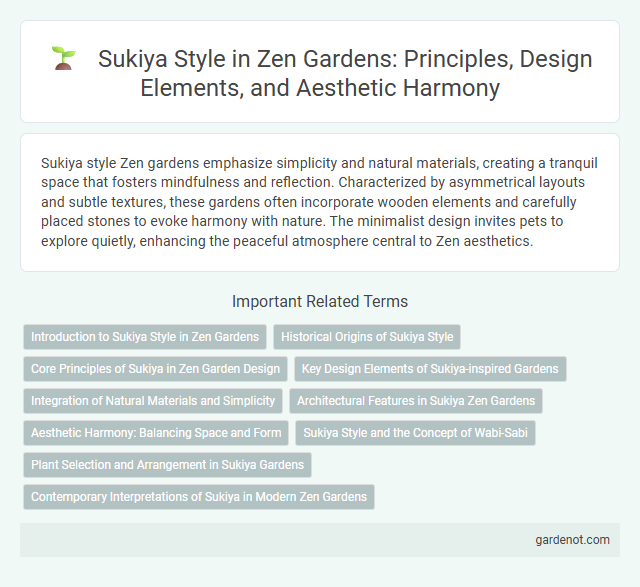Sukiya style Zen gardens emphasize simplicity and natural materials, creating a tranquil space that fosters mindfulness and reflection. Characterized by asymmetrical layouts and subtle textures, these gardens often incorporate wooden elements and carefully placed stones to evoke harmony with nature. The minimalist design invites pets to explore quietly, enhancing the peaceful atmosphere central to Zen aesthetics.
Introduction to Sukiya Style in Zen Gardens
Sukiya style in Zen gardens embodies simplicity, natural materials, and asymmetry to create tranquil, meditative spaces. Characterized by rustic wood, bamboo, and delicate stone arrangements, this aesthetic emphasizes harmony with nature and understated elegance. The Sukiya approach integrates tea house design principles, fostering a serene environment that encourages reflection and mindfulness.
Historical Origins of Sukiya Style
The Sukiya style originated in 16th-century Japan during the Momoyama period, deeply influenced by the aesthetics of the tea ceremony and Zen Buddhism. It emphasizes simplicity, natural materials, and asymmetry, reflecting a philosophical shift toward rustic elegance and spiritual tranquility. This style represents a fusion of traditional Japanese architecture and the cultural ideals of wabi-sabi, highlighting imperfection and impermanence.
Core Principles of Sukiya in Zen Garden Design
Sukiya style in Zen garden design emphasizes simplicity, natural materials, and asymmetry to create a serene and contemplative atmosphere. Core principles include the deliberate use of space (ma), understated elegance, and harmony with nature, reflecting the wabi-sabi aesthetic of imperfection and transience. This approach integrates carefully arranged stones, minimalistic plantings, and textured surfaces to evoke quiet reflection and spiritual balance.
Key Design Elements of Sukiya-inspired Gardens
Sukiya-style gardens emphasize natural materials, asymmetrical layouts, and seamless integration with surrounding architecture to create a tranquil atmosphere. Key design elements include carefully placed stones, low wooden fences, and minimalist plantings like moss and evergreen shrubs that evoke simplicity and elegance. Water features such as shallow basins and subtle pathways enhance the sensory experience while maintaining a refined balance between nature and human craftsmanship.
Integration of Natural Materials and Simplicity
The Sukiya style in Zen gardens emphasizes the harmonious integration of natural materials such as bamboo, stone, and wood to create a serene and balanced environment. This design philosophy prioritizes simplicity by avoiding excessive ornamentation, allowing the natural textures and forms to speak for themselves. The result is a tranquil space that fosters mindfulness and a deep connection to nature.
Architectural Features in Sukiya Zen Gardens
Sukiya style Zen gardens emphasize simplicity and natural materials, integrating tatami mat proportions and shoji screens to create harmonious indoor-outdoor transitions. Key architectural features include wooden verandas (engawa), carefully arranged stones, and subtle water elements that enhance tranquility and mindfulness. The design prioritizes asymmetry and wabi-sabi aesthetics, fostering a serene atmosphere reflective of traditional Japanese tea houses.
Aesthetic Harmony: Balancing Space and Form
Sukiya style in Zen gardens emphasizes aesthetic harmony by carefully balancing space and form to create a tranquil atmosphere. This design philosophy integrates natural materials, asymmetrical arrangements, and minimalistic elements to achieve a seamless flow between architecture and nature. The subtle interplay of voids and solids enhances visual rhythm, fostering a meditative environment rooted in simplicity and elegance.
Sukiya Style and the Concept of Wabi-Sabi
Sukiya style in Zen gardens emphasizes simplicity, natural materials, and understated elegance, reflecting the principles of Wabi-Sabi, which values imperfection, transience, and rustic beauty. This design approach creates a tranquil environment by incorporating asymmetry, rough textures, and muted colors that evoke a deep connection with nature. The concept of Wabi-Sabi in Sukiya style encourages appreciation of the ephemeral and imperfect, fostering meditation and mindfulness within the garden space.
Plant Selection and Arrangement in Sukiya Gardens
Sukiya style gardens prioritize natural simplicity by selecting native plants such as maple, pine, and bamboo that emphasize seasonal changes and subtle beauty. Plant arrangement follows asymmetry with careful spacing to create harmony, allowing each element to breathe within the tranquil setting. This approach enhances the meditative atmosphere by blending organic textures and colors that evolve throughout the year.
Contemporary Interpretations of Sukiya in Modern Zen Gardens
Contemporary interpretations of Sukiya style in modern Zen gardens emphasize minimalist design principles, natural materials, and harmonious integration with the surrounding environment. These gardens often feature clean lines, subdued color palettes, and carefully arranged elements such as rocks, gravel, and native plants to evoke tranquility and balance. The fusion of traditional Sukiya aesthetics with modern landscaping techniques creates spaces that offer both spiritual reflection and contemporary visual appeal.
Sukiya style Infographic

 gardenot.com
gardenot.com